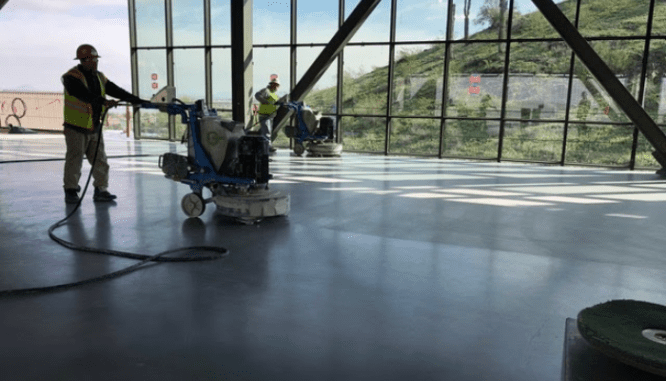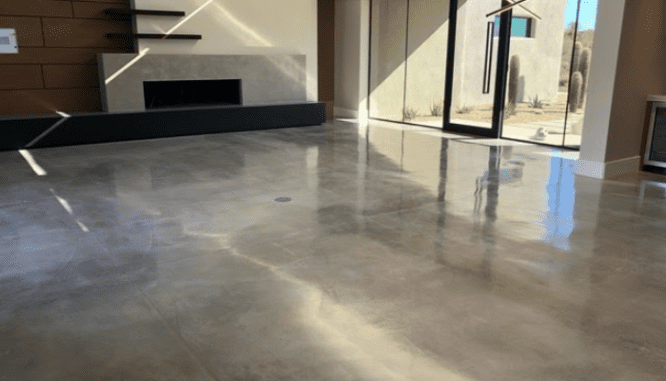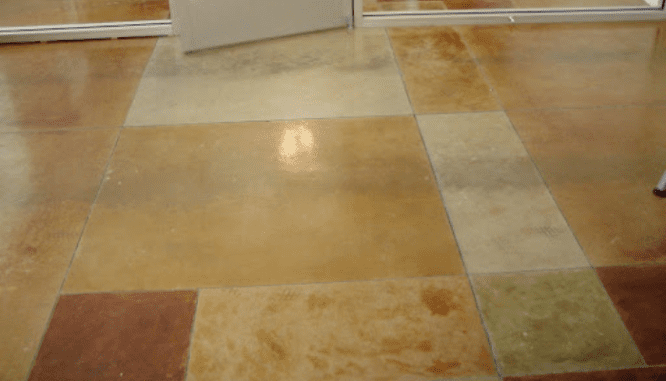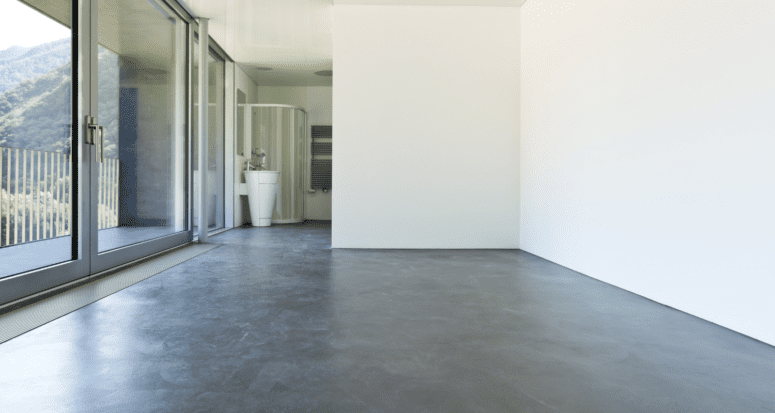Sleek, Concrete Flooring Is In for Modern and Industrial Interiors
- Published on
- 9 min read
-
 Allaire Conte Contributing AuthorClose
Allaire Conte Contributing AuthorClose Allaire Conte Contributing Author
Allaire Conte Contributing AuthorAllaire Conte is a writer with a passion for real estate, technology, and nature. She holds her MFA in Nonfiction Writing from Columbia University and is based in Brooklyn.
Concrete floors are everywhere. If you haven’t noticed yet, you will now that we’ve pointed out the material’s ubiquity.
During the past decade, top interior designers have embraced concrete for chic New York lofts and modern farmhouses. While concrete for residential flooring is not a recent adaptation (just look at iconic architect Frank Lloyd Wright’s 1948 Wisconsin property featuring red-stained concrete floors), it’s never been a more popular choice for the everyday homeowner.
If you’re looking to get in on one of today’s hottest flooring trends, we’re here to help. Whether you already have a concrete floor you want to spruce up, or you’re starting from scratch, this article is for you. We’ll break down everything you need to know about concrete floors — from slab to sealant.

Concrete flooring for your home
New flooring is one of the most high-impact upgrades when it comes to remodeling your home. This project offers a solid ROI when you choose a low-cost option. Plus, a National Association of Realtors (NAR) study reveals that new floors ranked the fourth-best home improvement to attract potential buyers. Whether you’re looking to sell or are simply in the market for a new look, concrete is a stylish, affordable, and low-maintenance flooring option for your home.
Maintenance
If you’ve ever replaced your flooring, then you know there’s nothing more satisfying than that “brand new” feeling. But keeping that spotless look can become a full-time job if you choose a material prone to staining and dulling. If you don’t want to spend hours on upkeep but still want that brand new shine, concrete floors are the perfect low-maintenance option.
So long as your concrete floors are installed and sealed correctly, the only regular maintenance you’ll need to do is sweep and damp mop to restore them to their original glory. Minor blemishes like cracks and holes cost between $5 to $150 to fix; you can tend to these DIY-style or call in a pro for maintenance.
Sounds too good to be true? Consider this: What does the flooring look like at your local Costco or Home Depot? Chances are, it’s fairly immaculate concrete.
“You see [big retailers] all have polished concrete because your cost per square foot to maintain that floor is far less than other options,” Eric Pottle with top-rated Concrete Interiors in Phoenix, Arizona comments.
Durability
Another reason why many retailers choose concrete flooring is for the material’s astounding durability. Pottle says that concrete floors “tend to be the most resilient” option so long as they are cleaned regularly. Concrete is inherently hardy, and most finishes for concrete treat the material to make it denser and more durable.
Concrete flooring costs
If that isn’t enough to convince you, the affordability of concrete floors just might. Take a look at how the cost of concrete stacks up to the most popular flooring options:
- Concrete: $3-$15 per square foot
- Hardwood: $10-$18 per square foot
- Engineered wood: $6-$20 per square foot
- Laminate: $6-$9 per square foot
- Carpet: $1-$3 per square foot
Concrete floors are a clear contender for the most inexpensive option. And since concrete requires little maintenance, it’s one of the most affordable options in the long run, as well.
Still, $3 to $15 is a wide range, and where the cost of your concrete floor will fall within that span depends on several factors:
Slab
All concrete floors share the same foundation: a slab of structural concrete. If you’re starting from scratch, pouring a slab costs between $1 and $5 per square foot, but prices vary depending on the thickness and location of the slab. Designers recommend a block thickness of four inches for a standard floor or five to six inches for heavy load-bearing floors (like garages or workshops).
Finish
Concrete floors don’t just come in 50 shades of gray. Whether you poured it yourself or pulled up your carpet to find a blank concrete canvas, you have several options for dressing up your slab. Just know that the finish you choose can have a big impact on your bottom line. Read on to learn more about the different styles and costs associated with concrete floor finishes.

Finish options
If you’ve decided that this affordable, low-maintenance floor is for you, you’ll have the opportunity to choose from a variety of finish options. We’ll break down the most popular concrete floor finishes below to help you seal the deal.
Polished
Polished concrete floors are a design trend that hit their peak in March 2019 and have maintained popularity since then. This finish is lauded for its chic high sheen and low-maintenance nature.
To give your floors that beautiful shine, concrete professionals use heavy-duty grinders to gradually grind down the grit of concrete to your desired level. Because it is a gradual process, you have a wide berth in selecting a finish from dull to near reflective.
Despite their reflective surface, polished concrete floors don’t need wax or sealant. All these floors need is regular sweeping to remove dust and dirt that can scratch the finish. You also should swiftly clean up spills since while concrete repels dust and dirt, it can be porous, so liquid spills can leave a stain if left unattended.
Polished concrete costs between $3 and $8 per square foot, with the average job costing around $2,690.
Stained
Stained concrete had a moment in the mid-2000s alongside the Tuscan home design wave, and (unlike Tuscan design) is making a comeback today. There’s no shortage of options for what these floors can look like: From bright organic shapes to toned down swaths, acid stains can be tailored to fit your home.
This finish does need slightly more maintenance than the near-effortless polished concrete, though. Stained concrete requires regular waxing to protect the sealant used to lock in the stain. If the sealant is penetrated, it can be difficult and expensive to restore, so it’s best to stay on top of it by waxing your floors four times annually. That’s still a low lift compared to other flooring options, and it’s all worth it for the stunning appearance of stained concrete.
Acid-based stain
Acid-based concrete stains are made up of metallic salts dissolved in a solution of acid and water. These stains impart a partially translucent color with some variation in tone for a watercolor-like finish.
For an idea of the range of color options available, check out this swatch that includes options ranging from coffee to turquoise. Also, note that you don’t have to limit yourself to one color. You can blend multiple shades to create a marbled or swirled look if desired.
Expect to pay about $6 per square foot for basic designs or more for complex finishes.
Water-based stain
This blend of acrylic polymers and pigments penetrates the concrete to leave a stain. Unlike acid-based stains, no chemical reaction occurs when water-based stains meet concrete, resulting in a uniform finish. Water-based stains are an ideal option for those who want depth in their floors but aren’t looking for as dramatic of a look as the acid-based stain style.
Another benefit: Water-based stains are low in Volatile Organic Compounds and are generally considered safer and more environmentally friendly than other finish options.
Color-wise, there are just as many options for water-based stains as there are for acid-based stains. Check out this swatch from Surecrete that includes semi-transparent and solid color options.
Water-based stains are also a real money-saver, running around $2 per square foot.
Dyed
Concrete dyes, like water-based stains, impart color by penetrating concrete’s surface; however, dyes have a smaller particle size than most stains, which allows for better saturation of color. Dyes are a great option if you like the look of a stain but want an even application. Like acid and water-based stains, there’s a dye for just about any color imaginable.
The maintenance for dyed concrete floors is comparable to stained concrete floors with the additional caveat that they will need to be resealed every one to two years. In addition, you should wax dyed concrete regularly to protect the seal in between reapplication.
Expect to pay within the range of concrete stains for this finish, between $2 to $6 per square foot.

Epoxy
Epoxy provides a slip-resistant and durable coating to concrete floors. To maintain this finish, perform routine maintenance of sweeping and dust-mopping to remove any particles that could scratch the coating. If it seems like your floor is losing its shine, it’s probably time for a deep clean mop or squeegee.
An epoxy coating won’t last forever, though, especially if your floor is in a high-traffic, heavy-load area. If you notice the veneer chipping, call in a professional to apply a fresh coating.
Metallic and colored
Metallic epoxy floors give a glossy sheen to any room. Unlike staining or dying your concrete floors, epoxy provides a uniform coating of color. Choose from a wide range of colors to find the perfect patina for your interior.
This finish option costs between $5 to $12 per square foot, with neutral colors on the cheaper end of the range and bright ones on the more expensive end.
Quartz sand
It’s also possible to give your concrete floors a little texture and depth with a sand finish. Quartz sand can be added to epoxy for extra strength and slip-resistance. The grainy look can also be made to mimic high-end quartz terrazzo floors.
Quartz sand concrete floors cost between $2.50 and $3.50 per square foot.

Geometric designs
Patterns are a hot flooring trend for 2021, and concrete offers innumerable options to punch up interiors with a stylish motif. You can add designs in concrete flooring in several ways:
Stamping
You don’t have to go with a uniform slab: You can use stamps to impart extra texture and shape onto your floor. Stamped concrete is more affordable than the natural stone it mimics and comes in near limitless design options. This option costs between $8 to $28 per square foot.
Stencils
You can also use stencils to give your concrete floors a little character. Like stamping, stencils are often used to mimic the appearance of tile and break up the monotony of a slab. This finish ranges from $8 to $12 per square foot.
Airbrush
With airbrush techniques, your floor is your canvas. You can use the airbrush method to make your concrete mimic natural stone, or apply more intricate designs, like a logo or monogram. Costs vary widely depending on the complexity of the job.
Overlay
Professionals can revamp concrete floors with superficial damage by applying an overlay, a thin layer of concrete. They’ll clean, patch, and prime your existing slab to ensure that the overlay adheres properly. Once the pros pour the overlay, they can add any of the finishes above to give your floors a new look.
An overlay runs $3 to $7 per square foot, with an additional cost for any finish on top of the overlay.
Seal the deal
If you’re considering new flooring, concrete floors are a solid option. They offer a triple threat of style, durability, and affordability. While the concrete design trend is still young, don’t worry about this going out of style anytime soon. The longevity of this material promises to keep concrete floors en vogue for generations to come.
Header Image Source: (alexandre zveiger / ShutterStock)
